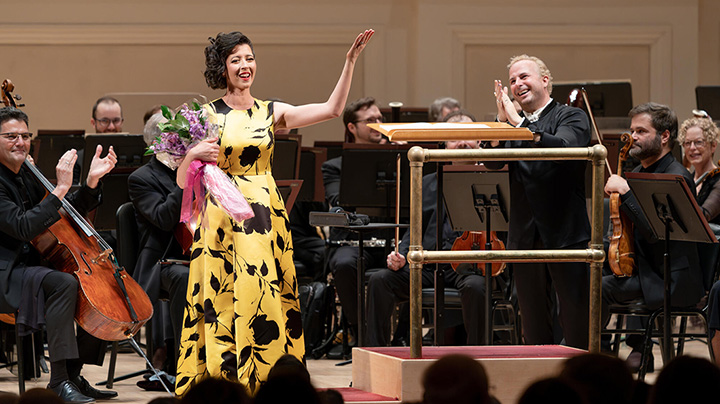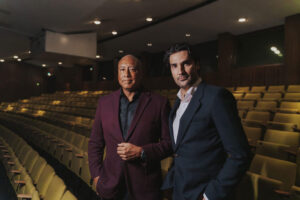The summer concerts that the Metropolitan Opera Orchestra programs at Carnegie Hall after the regular opera season ends are always refreshing and reveal the versatility of the musicians in standard (and not so standard) classical concert repertoire. The orchestra musicians seem to be in a holiday mood and can explore musical roads not taken in their operatic careers. The program:
JESSIE MONTGOMERY “Hymn for Everyone”
MOZART “Vado, ma dove?,” K. 583 ( Lisette Oropesa, soprano soloist)
MOZART “A Berenice … Sol nascente,” K. 70 (Lisette Oropesa, soprano soloist)
BRAHMS Symphony No. 1
My reaction to this program was, do these pieces have anything to do with each other?
Well, upon hearing the concert, I felt they each shared a similar emotional arc – working through uncertainty, angst, and adversity to find spiritual recovery and wholeness with a glimmer of hope (however uncertain) on the horizon.
Jessie Montgomery is a 43 year-old composer-violinist whose compositions have been gaining traction in concert halls throughout the country. Her Hymn for Everyone (composed 2021), an approximately 12-minute orchestral poem, was commissioned by the Chicago Symphony Orchestra and premiered in April 2022 under the baton of Maestro Riccardo Muti.
Montgomery describes herself as a “hunter gatherer” musical creator – she takes and synthesizes traditional tonal classicism with improvisatory jazz, traditional African-American folk music or popular music et al. to create a unique musical palette. This brief work is entirely tonal and in a classical American idiom reminiscent of Samuel Barber or Aaron Copland. Hymn for Everyone works solidly and expressively in that tradition rather than presenting some sort of clever pastiche or self-conscious homage. Montgomery is fluent in the idiom and uses it with both technical surety and expressive honesty.
Hymn for Everyone was composed as the world was emerging from the COVID-19 pandemic – the searching and tensive string writing in the first part suggests someone stumbling into the street after being confined indoors unsure of the world around them, their eyes blinking at the sun. Eventually, there is a sense of becoming more at ease in the world and finding one’s footing.
At the time Montgomery was composing the piece, she was dealing with turning 40 and losing her beloved mother in May 2021. She found herself seeking “a bit of catharsis” and expanded her new composition from a suite of orchestral miniatures into a hymn not just for herself but for everyone emerging from shadows into light.
There is a lot of texture and variety in the piece including a central brass chorale. Montgomery is not afraid of melody or tonal beauty. It was played beautifully by the Met Orchestra and Nézet-Séguin. Montgomery herself, who grew up in Manhattan on the Lower East Side, was in the audience and was invited up onstage by the maestro to take a bow before an appreciative audience.
From then on it was diva time: Lisette Oropesa emerged radiant and smiling in a fitted canary yellow evening gown with black fabric appliqué decorations sporting a diamond clip in her ebony hair, welcoming the enthusiastic applause. For a singer who is a product of the Met’s own Lindemann program, coloratura Oropesa recently has not been a frequent presence with the company – her last appearances were in December 2022 in a revival of Bartlett Sher’s muddled production of Rigoletto. I don’t see her name on the roster for next season.
Here she performed, too briefly, two Mozart concert arias from different parts of his career. The late career “Vado, ma dove” (1789) and a celebratory piece composed when Mozart was 13 years-old, “A Berenice … Sol nascente” (1769). Both pieces only added up to about 15 minutes of music but displayed many facets of her radiant and sparkling vocal arsenal.
“Vado, ma dove” is an insert aria for the Martin y Soler opera Il Burbero di buon core composed for the original Dorabella, Louise Villeneuve. In the aria a spendthrift wife, Lucilla, repents her profligate, careless ways realizing she has put her home and marriage at risk. At first, Lucilla pleads to heaven for comfort and aid and then invokes love to guide her way. Mozart begins with restless melodic lines reminiscent Fiordiligi’s more agitated music but the music turns serene and hopeful with broader lyric phrases in the final section. Oropesa was sure-footed and the plaintive purity of her crystalline tone suited the mood beautifully.
“A Berenice … Sol nascente,” was a celebratory occasional piece composed by the adolescent Mozart in 1769 to honor his employer, the Archbishop Sigismond von Schrattenberg, on the occasion of his birthday in Salzburg. This celebratory ode is over 10 minutes long and has a long introductory recitative that turns into a florid ode to the wise and modest ruler whose regal virtue is compared to the rising sun. The stilted classical formality of the text is contrasted with Mozart’s sprightly and inventive music which culminates in tripping cadenzas and vaulting staccati for the vocal soloist.
Oropesa here had room to show off her virtuoso coloratura side with sparkling high notes dancing up the scale and firm trills embedded in the complex vocal line. On her social media, Oropesa has complained of a lingering upper respiratory infection that has been audible in some recent performances which have suffered from hints of strain and dull tone. Here, except for one floated high note that slightly faltered, everything was silvery and poised and her spirit was generous and enthusiastic.
The diva was rewarded with a rapturous ovation, adoring embraces from the maestro and a floral tribute from our very own Grimoaldo, the greatest Oropesa fan ever (so I was informed here). Alas, there was no encore though everyone wanted one…
After intermission, we were jolted into late nineteenth century German High Romanticism with b and his long-gestating Symphony No. 1 in C Minor, Op. 68 (1876). Here we had another journey from dark uncertainty into joyful light. Brahms traces a course from an ominous C-minor opening to a jubilant C-major coda of the finale which has been compared to Beethoven’s “Ode to Joy” in his 9th Symphony.
I remember some wit, likely Sir Thomas Beecham, opining that there are two kinds of conductors – too slow and too fast. There is no third… Yannick Nézet-Séguin definitely falls into the latter category.
His fleet and forward moving, low calorie, lighter textured approach to 19th century German music (including his Wagner at the Met) is either refreshing and salutary or off-putting and alien sounding to listeners depending on one’s taste and preference.
On this occasion, I found that the internal variety, clear delineation of orchestral layers, pinpoint dynamics and buoyant energy of his reading had an exhilarating effect and the Met Orchestra was on point and on fire. Brahms’s menacing introduction and moody first movement were perhaps not as dark and weighty as one would get from a different maestro but were never bogged down and were shaped persuasively with detail. He found a chamber orchestra – or several – within a massive symphony orchestra. In the complex major key finale, Nézet-Séguin relished and luxuriated in each melodic theme that emerged with endless variety while whipping the orchestra into a rushing whirlwind of excitement and ecstasy. It may not have been echt, but it was fun!
I think we all have dealt with some dark episodes lately and this journey into hope and peace that the Met Orchestra and Maestro Nézet-Séguin took us on was welcome as we emerged into a cool and clear June night.
Photo: Jennifer Taylor




